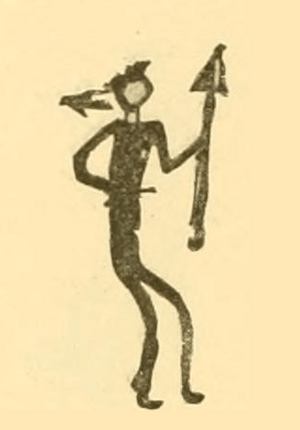Battle at Blue Coat's Village facts for kids
Quick facts for kids Lakota attack on a Pawnee village |
|||||||
|---|---|---|---|---|---|---|---|
|
|||||||
| Belligerents | |||||||
| Brule and Oglala Lakota | Kitkahahki and Tappage Pawnee | ||||||
| Commanders and leaders | |||||||
| Unknown | Blue Coat | ||||||
| Strength | |||||||
| Estimated 300 Lakotas | Around 40 earth lodges | ||||||
| Casualties and losses | |||||||
| Some, but unknown | More than 65-70 men and women killed, maybe some children. | ||||||
On June 27, 1843, a group of Lakota warriors attacked a Pawnee village. This village was led by Chief Blue Coat and was located near the Loup River in Nebraska, at a place called Plum Creek. This attack was a very serious event for the Pawnee people. It was their biggest loss until another Lakota attack in Massacre Canyon in 1873. About 65 to 70 Pawnee people were killed. A few of their traditional earth lodge homes were also burned.
Why the Attack Happened
In the 1840s, the Pawnee people were divided into four main groups. They lived in villages made of earth lodges along rivers that flowed into the Loup River. Chief Blue Coat's village was home to the Kitkahahki (or Republican) Pawnee. It was located near Plum Creek, north of the Loup River, in what is now Nance County, Nebraska. This village had about 41 earth lodges. Some sources say it had 14 lodges of Republicans and 41 lodges of Pitahawiratas (or Tapages). A new Presbyterian mission was about a mile away. People at the mission could easily see the Pawnee village.
For many years, the Pawnee and Lakota had been enemies. The Pawnee's power was getting smaller, while the Lakota were growing stronger. In the days before the attack, the Pawnee villagers found signs of strangers nearby. They saw worn-out moccasins and feathers in the grass. They also noticed signs of people moving around at night.
The Battle Begins
About 300 Lakota warriors, possibly from the Brulé and Oglala Lakota groups, launched a big attack on the village. It happened at dawn on June 27. The Lakota force was so large that they formed a line from the bluff to the river, which was over a mile long. Waves of warriors on horseback, many with guns, rode quickly through the village.
The Pawnee sent messengers to ask for help from other villages. They tried to protect as many earth lodges as they could. Some women and children were scared. They thought they would be safer outside the lodges, so they ran towards the river. This made them easy targets for the attackers. Some children were even taken captive.
Around 8 o'clock in the morning, the Lakota controlled almost half of the village. They set 20 lodges on fire. It was likely during this time that a Lakota warrior found one of the Cheyenne's four sacred arrows, called the Mahuts. The Pawnee had won these arrows in 1830. Chief Blue Coat's village might have been guarding one of these special items.
Before noon, the Pawnee villagers got help from other villages located further west. With these new fighters, the Lakota decided to retreat. They took about 200 of the Pawnee's horses with them.
After the Fighting
During the attack, the white people at the nearby mission stayed in their homes. They knew this was a conflict between the Pawnee and the Lakota. However, the attackers did kill a mixed-blood Omaha woman who lived with a blacksmith. They also killed a mixed-blood Pawnee interpreter named Louis LaChapelle.
Once the attackers left, some people from the mission quickly went to the village. The Lakota had killed more than 65 Pawnee people, including Chief Blue Coat. The Pawnee claimed they had killed many Lakota warriors, whose bodies were carried away by their comrades.
What Happened Next
The Lakota warriors recognized the special Medicine Arrow of the Cheyennes. They gave it back to their allies, the Cheyenne. The Cheyenne already had one of the arrows that had been lost 13 years before. George Bent later shared this story, saying, "... the Brule Sioux captured a Pawnee village ... and in this camp they found another of the Medicine Arrows, which they returned to our tribe with great ceremonies." Bent thought this happened in 1837. However, four Lakota winter counts (historical records kept by Native American tribes) show the year as 1843.
The next year, some Pawnee warriors told Lieutenant J. Henry Carleton about their difficult situation. They said the Lakotas "burned our lodges and murdered our women and children." Carleton felt sad about Chief Blue Coat's death. He had met the chief at Council Bluff once and they had exchanged gifts.
The deserted Pawnee village was not rebuilt right away. The people who survived went to live in other villages. It is likely that military surveyor G. K. Warren was talking about Blue Coat's village in his 1857 journal. He wrote, "The [village] ... was lately deserted. The charred upright beams still standing."
Fighting between the Pawnee and the Lakota continued for years. In the summer of 1845, a Lakota war party burned many earthlodges. This happened while the Pawnee villagers were away on a tribal hunt. Again, in 1860, some Lakotas set fire to more than 60 lodges in a Pawnee village. They were helped by Cheyenne and Arapaho warriors.


